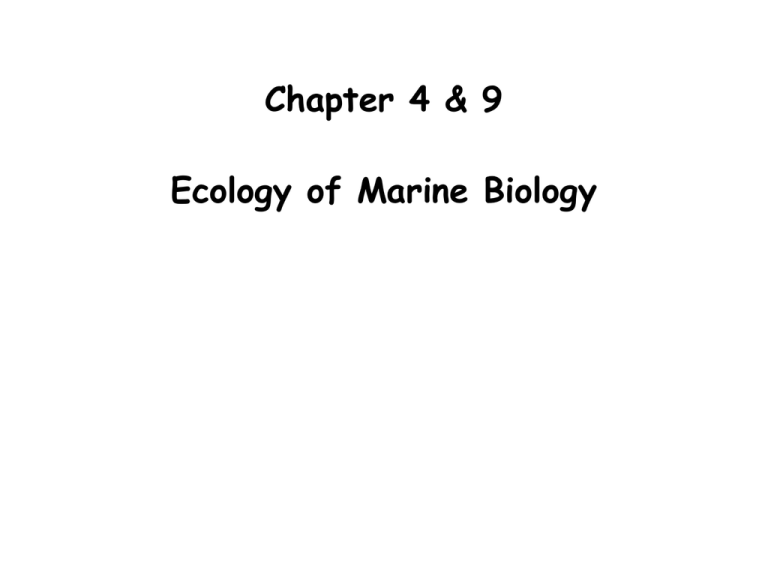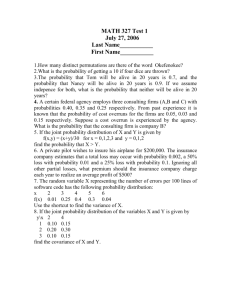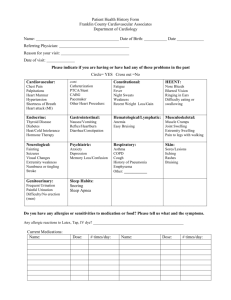Chapter 4 & 9 Ecology of Marine Biology
advertisement

Chapter 4 & 9 Ecology of Marine Biology Is it Alive? • Observe object: • 1-Tell what you think object is. • 2-Place specimen in one of three categories: – A- is alive – B- Not alive now-used to be alive or came from something that was alive – C-Not alive, never was alive • 3-Then list characteristics that helped you decide A, B, or C. Is it Alive? • Step 1 • Go through your list of characteristics. Were the characteristics chosen absolutely necessary for the maintenance of life? Hint: (If you can think of any organism that does not have to do that, it is not necessary. Write “N” for necessary beside the appropriate characteristics. Is it Alive? • Step 2 • Were there any characteristics that would appear in all specimens? Make a list of these characteristics on the bottom of your page. Is it Alive? • Step 3 • Now write a definition for “life” including as many characteristics of life as possible on the back of your handout. Is it Alive? • Step 4 • Now in a group of students assigned by your teacher discuss your definition for “life” including as many characteristics of life as possible. Make sure that all members of your group can defend the group’s answers. Be ready for class discussion. Requirements of Life 1. Process energy and material Examples: Requirements of Life 1. Process energy and material Examples: 2. Maintain organization, grow, and reproduce Examples: Requirements of Life 1. Process energy and material Examples: 2. Maintain organization, grow, and reproduce Examples: 3. Respond to environment Examples: Joshu’s new grocery store • • • • • • • • • • • • • • • • Frozen Dinner Milk Meat Donuts Mac/Cheese Ribbon Bread Motor Oil 12 Pack Pepsi Nails Water Cheese Laundry Soap Eggs Rope Chips Pounds Dozens Gallons By the Foot Package Levels of Organization of Life 1. 2. 3. 4. 5. Cell Individual Population Community Ecosystem Macromolecules Lipids - Fat, Cholesterol, Steroids Carbohydrates - 1. Simple - glucose (sugar) - 2. Complex - starch Protein - amino acids Nucleic Acid - DNA/RNA Plants capture the suns energy and turn it into food for themselves (photosynthesis) Photosynthesis H2O + CO2 Reactants C6H12O6 + O2 Products Respiration C6H12O6 H2O + CO2 + Energy Photosynthesis Respiration is the opposite of photosynthesis. Respiration breaks down organic matter, using O2 and producing CO2 and H20. Cells Prokaryote - Bacteria Eukaryote - Plants, Animals, Protists, and Fungi Prokaryotic cell (bacterium) – no membrane bound organelles – smallest and simplest. Bacteria were the first life forms on the earth. Fossil bacteria show an age of 3.8 billion years old, almost as old as the ocean itself. Eukaryotes – contain membrane bound organelles (plant and animal cells) Reproduction Strategies Prudent Prodigal Few young Many young Energy is invested in care of young 1 -12 Mammals Whales Dolphins Energy is invested in making an enormous amount of young 100’s some fish 1000’s Fish/invertebrates Sponge sea urchin Sea grass reproduction by runners or stolens. Sexual reproduction by Sea Urchin Giant Clam reproducing by broadcast spawning. Male jawfish incubate eggs in it’s mouth. Fur seals care for their young for a long time. Fungi Protista Mushrooms Plantae Sea grass Ex.Ameoba Mold Mangrove Diatom Dinoflagellate Animalia Algae Algae Modern Bacteria Protista Monera Archaebacteria Ciliates Flagellates Classification based on cellular organization and mode of nutrition All Life Prokaryotes Eukaryotes (Bacteria, monera) Single cell or multi cell (Protista) Complex Muticellular Photosynthetic Autotroph Heterotroph (Plant) Absorb Catch (fungi) (animal) Trophic Levels Producers - Autotroph Consumer - Heterotroph Scavenger Carnivore Herbivore Omnivore Decomposer Filter Feeder Detritavore DOM C-5 Consumer Heterotroph C-4 C-3 C-2 C-1 Car. Car. Carnivore Carnivore Herbivore (zooplankton) Producers (Autrotroph Phytoplankton) Food Chain Shadows in a Desert Sea Sea of Cortez Dolphins Sardines Mycid Shrimp Phytoplankton Food Chain FOOD WEB FOOD WEB FOOD WEB FOOD WEB exponential growth

